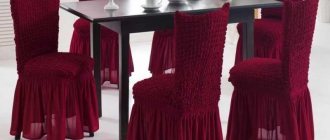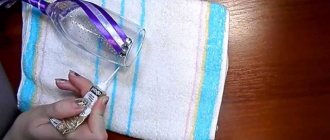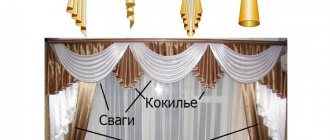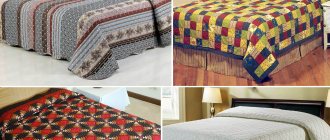A bed with a good, comfortable mattress is the key to a restful, healthy sleep. To keep it clean longer, it is better to use a protective fabric covering that you can make yourself.
The mattress pad should be thick enough to better protect the mattress and securely attach to it.
Not everyone believes that its presence is necessary, but the beneficial properties speak for themselves:
- reliably protects against contamination;
- preserves the original appearance of the mattress for a long time;
- protects against the appearance of allergens and dust on the surface.
A mattress cover or pad primarily performs a hygienic function - it protects the mattress from dirt, it is easy to remove and wash.
How to sew a mattress cover with your own hands
Sewing is not an activity that everyone can do, but almost every housewife can make a mattress cover. You will need to buy the fabric you like, and then:
- acquire dressmaker's tools: scissors, threads, needles, measuring tape;
- prepare the iron;
- set up the sewing machine.
The simplest one looks like a large pillowcase or bag.
To prevent it from “slipping,” you can simulate a button closure or zipper. There are other options for fastening.
How to sew a mattress cover with an elastic band - simple instructions
A mattress cover with an elastic band assumes the presence of sides
In order for the product to hold firmly, reliable fastening is required in various ways. You can always learn how to sew from expert consultations. For sewing you need:
- prepare sewing tools;
- choose the material you like based on your ideas about the appropriateness of use and beauty;
If the mattress cover should protect only from dirt and dust, choose thick cotton, linen, jacquard, thin terry cloth, bambooIf you also need waterproof functions, we take fabric or material with waterproof lamination
A quilted mattress cover with a thin padding polyester layer is good for winter, it retains heatJacquard or silk mattress cover, good in hot weather, as it gives a feeling of coolness
- buy an elastic band – wide or underwear;
- make a pattern by measuring the length and width, and if necessary, the height.
Pattern with allowances for sewing a mattress cover with an elastic band
The order of sewing operations, if the skill is small, can be found on the Internet.
Benefits of a branded product
If the DIY process turns out to be too complicated or there is simply no time for it, you can turn to traditional methods and purchase a branded product. The Molto Bene company offers options for Italian mattresses for every taste. A wide range of inexpensive and affordable models, original and exclusive options.
And in conclusion, I would like to note that the main advantages of high-quality mattresses are sound and healthy sleep, the adoption of an anatomical position for the spine and joints. The design of the mattress is designed in such a way as to relieve tension from the entire body and allow muscles to relax.
PLEASE SHARE THIS POST!
We sew a mattress cover with an elastic band with our own hands
Transfer the pattern to the fabric and cut out the mattress cover piece
Correctly folding the edges of the cutouts
A protective covering sewn with your own hands can be the first experience and pride of even an inexperienced craftswoman. To work, you will need a machine, traditional tailor's tools, fabric, accessories, a little skill and effort.
We sew and process the edges of our cutouts on all sides
We bend and iron all the free edges of the mattress cover
We sew the hem around the entire perimeter, leaving an opening about 4-5 cm wide
When choosing a material, you should pay attention to strength: it should not quickly wear out or tear.
Using a safety pin, thread the elastic into the drawstring
We cut the elastic a few centimeters longer than necessary, fold its ends, sew several times, closing the elastic in a circle
Having made measurements: length, width and height, you can start creating a pattern, and then sewing. Fastenings are sewn in along the edges, reliability is checked by fitting.
We sew up the remaining hole - the mattress cover is ready
Sew in an elastic band
There are several ways to sew elastic into a mattress cover. For example:
- Use an elastic band; the elastic is sewn onto the folded fabric using a zigzag stitch.
- The corner method is when pieces of elastic attached to the fabric grab the mattress at the four corners, preventing the fabric from moving.
- The standard method is to create a drawstring into which the elastic is pulled.
Note! In order to beautifully sew in an elastic band, one of the corners must be pre-processed, leaving a hole in it for pulling the elastic through, and the remaining corners must be stitched in the usual way. Insert an elastic band into the remaining hole using a pin and tighten it.
The final touch is to insert the elastic
It is more convenient to do this by pulling the cover over the mattress so as not to make a mistake with the length of the elastic band. Having stretched the elastic on the mattress, you can easily trim off the excess length and tie or sew the edges of the elastic together.
You may be interested in this: The procedure for taking measurements from a woman for sewing a dress
How to sew a mattress cover: step-by-step instructions
In order to make our future cover, we need to measure the length of the mattress a, width b, and side height h
The need to protect the product from contamination is quite justified: with its help, it stays clean longer and maintains an attractive appearance. The sequence of work can be learned from simple instructions, which will not be difficult to implement even for a novice home craftswoman:
- buy fabric;
- prepare tools for cutting and sewing: sewing machine, measuring tape, thread, needles, scissors, chalk, elastic band, iron;
- take exact measurements.
Attention! Before you start cutting, it is important to wash the purchased material: it can “shrink”.
We set aside ½ the width of the mattress from the fold line, on each side we set it aside to the left, to the right, and from the bottom h+15 cm
Cut out squares at the corners with scissors
Experienced home craftswomen advise carefully checking the dimensions of the product before cutting.
Advice. For inexperienced housewives, it is better to make a life-size template and check the correctness of certain dimensions.
We transfer the pattern to the fabric, sew down sections C and C1, process the edges of the cut, and make a hem stitch along the entire product
Once the check has been completed, you can begin cutting, having first ironed the fabric well. The main part is cut taking into account the length and width, then 4 side fragments are cut out if the mattress is high.
We retreat from the corner 50 cm, thread the elastic, secure the ends of the elastic with stitches - we get gathering in the corners
All parts are double stitched and folded inside out, then turned inside out.
If the fitting was successful, you can create a drawstring. Iron the finished product.
Ready-made mattress cover with elastic band with gathering in the corners
Pattern for the case
Before you start cutting out, choose what type of mattress cover to sew. A sheet with elastic bands in the corners is pulled together at the corners; if desired, a padding polyester layer is sewn to it. A mattress topper with sides has an elastic band around the perimeter of the fabric. This case holds more firmly, because the sides go under the mattress, and there the edges are tightened with an elastic band.
- Case with corner elastic bands. They can do without a pattern, because this option is easy. You only need a sheet of paper to take measurements and make a drawing. If the mattress is orthopedic, then you will need to transfer the shape of the corner onto paper, since they are often rounded. This corner is cut out and applied to the fabric as a template.
- Mattress cover with sides. The principle of operation is almost the same as for the previous case:
- measure length, width and thickness;
- take all measurements and make a drawing;
- make a template for the corners;
- cut out the base of the cover;
- cut out the side stripes.
The width of the strip for the side is equal to the thickness +1-2 cm for the allowance +10 cm (what is under the mattress) +3 cm for sewing on the elastic.
When drawing a drawing, take into account seam allowances of 1-2 cm;
How to sew a mattress cover for a baby
You can make a cover for a children's mattress with a zipper yourself
It is very easy to make a cover for a children's mattress. How to sew it yourself is easy to understand from the recommendations. You will need:
- take measurements;
- purchase and wash fabric;
- prepare tailoring tools and machine;
- cut out two rectangles: one to size, the second with an allowance of 2-3 cm on each side.
Three sides and part of the fourth, where a zipper or buttons will be sewn, are stitched and stitched by hand.
When a zipper is used, it is first basted and tried on. If everything is done correctly, it is sewn into place. After ironing, the cover can be put on.
How to make a mattress harder or softer?
A topper is a thin mattress - a product that helps correct hardness. Models made of latex, soft polyurethane foam or holofiber will add softness to the sleeping surface. Latexed coir is a hard filler.
Reference! Like a mattress, you can make your own topper.
DIY mattress cover for children and adults
For a mattress for a child and an adult, the covering is made according to the same pattern. This takes into account the material, quality and texture, in accordance with the purpose of use.
The main conditions for a good result are:
- strict adherence to dimensions;
- washing the fabric before cutting;
- careful handling of corners;
- the reliability of the fastener or the correct fastening.
When choosing a fabric, especially when it comes to a children's product, it is important to pay attention to its composition, which should not cause allergies.
What materials and tools will be needed
Even those who last sat down at a sewing machine in high school can sew a mattress cover with their own hands.
Measurements
The first step is to decide how much fabric you will need. To do this, we measure the mattress: length, width, height. The piece of fabric must be at least:
- double length mattress;
- its double width;
- if the model has sides, then you need to add the height of the mattress, multiplied by 4, while two heights are cut in width, and two in length; if you are sewing a cover with corner elastic bands that will not protect the sides of the mattress, then the height is not taken into account .
Don't forget to allow seam allowances on all sides of the garment.
Fabric selection
First, let's decide on the material, as well as the functions that the product will perform.
If you want to extend the life of your mattress by protecting it from dust and dirt, then use fabrics that do not stain, do not shrink after washing, and do not fade. In this case, the coating will not spoil the sheets, and it can be easily washed without fear that after drying it will no longer fit. One of the successful options could be jacquard - a natural material that contains a small amount of synthetic fabrics. Silk is also suitable if you want a luxurious option, but keep in mind that silk is more difficult to work with due to its slippery surface. Simpler fabrics are chintz and calico, which are often used if you need to sew a mattress cover for a kindergarten.
To make the case waterproof, use special rubberized fabrics. If their surface is not too comfortable for the body, use the inner layer.
You will also need a border for processing seams, as well as fastenings of your choice:
- or thick wide elastic bands for fixing at the corners (2 pieces, if the model has opposite elastic bands, 4 pieces - for sewing into all corners);
- or an elastic band, the length of which is equal to the perimeter of the mattress minus approximately 40 cm.
Preparing tools
In addition to fabric you will need:
- spools of thread;
- scissors;
- chalk, which can be replaced with a simple pencil if the fabric is light, or with a piece of soap if it is dark;
If traces of soap, a simple pencil or chalk are visible on the finished product, do not worry. They will disappear after washing.
- centimeter (you can use a construction tape);
- safety and single-pin pins;
- sewing machine.
Pattern for a mattress cover with corner elastic bands
We pin the elastic bands to the corners of the mattress cover from the inside out
The model is quite simple. Elastic bands are sewn along the edges of the cut out rectangles to secure them to the surface of the mattress. The pattern can be found on the Internet.
Having folded the rapeseed tape in half lengthwise, we pin it along the entire perimeter of the mattress cover, grab the ends of the elastic, and stitch
Sewing a mattress cover
The amount of fabric depends on the type of case chosen and whether a padding polyester layer is sewn on.
For sewing bedding, they sell special material that is the same width as the mattress. Therefore, there is no need to sew the main part from several pieces of fabric. The price of such material is determined only by the length of the product.
The sheet model can be single-layer or double-layer. A padding polyester is sewn into a two-layer case, so they buy 2 times more fabric. Insulation is taken according to product measurements.
Mattress cover with corner elastic bands
First, a rectangle is cut out for a single-layer cover according to preliminary measurements. For a two-layer model, you need two identical rectangles, but it is better to add 3-5 cm so that the insulation does not bunch up at the edges. The corners are cut out according to the template.
- On a smooth surface lay a layer of fabric, padding polyester and again fabric. To ensure that everything is the same, the corners and cuts are aligned.
- The edges are pinned, then the product needs to be swept around the perimeter.
- The mattress cover is quilted, lines are marked in stages, and pins are pierced along the line.
- After stitching, the product is tried on. Excess edges are cut off.
- The elastic bands are pinned on the inside and the case is tried on again.
- Cut out bias tape, the width of which is the width of the finished part multiplied by 4, and 2 cm for thickness. The parts of the binding are connected at an angle of 45°.
- Stitch the binding on one side in a taut state.
- The trim is sewn on the outside so that the cut turns inward.
- Iron along the edges.
Cover for orthopedic mattress
An orthopedic mattress is expensive, so a cover for it will also be expensive, and many housewives sew it themselves. In order for the result to please you, the fabric needs to be:
- antistatic;
- hypoallergenic;
- breathable;
- did not absorb moisture;
- did not accumulate dust.
Jacquard is considered the most suitable, dense, durable, with a variety of colors.
You can use natural linen, cotton, as well as synthetic and mixed fabrics that do not cause allergies.
We create a comfortable mattress ourselves
Having decided to create an orthopedic mattress with your own hands, you need to consider a number of points.
- Qualities. Making a mattress with your own hands is quite possible. It can even be exciting. However, if you intend to get a quality product, you cannot do without accuracy, perseverance, patience and scrupulousness.
- Theory. If you only have the desire, but no special skills or even theoretical knowledge, it would not hurt to read several articles about the types of modern fillers and their properties, the required degree of mattress hardness and the materials used for sewing covers.
- Materials. The search for the materials themselves - blocks or layers of filler, special glue and fabric for covering - is a crucial moment. The degree of difficulty in finding high-quality, durable and safe materials will depend on the region in which you live. A big city means great opportunities, where there is an abundance of assortment. Residents of small towns and villages will have to spend time searching for a reputable manufacturer on the Internet and pay extra for delivery.
- Tools. Next, you will need to ensure that you have the necessary tools for the job.
- Case. If you don’t know how to sew, you need to think about someone who can help you calculate the amount of fabric for the cover and can make it.
If you have high-quality materials and a careful approach to business, you can count on quite good results!
Photo gallery of different types of mattress covers for children and adults:
PreviousMattressesWhich mattress is better, more practical: spring or springless?
Next
MattressesHow and with what to seal an intex air mattress at home?











